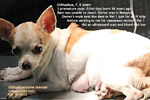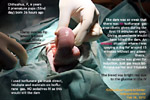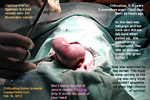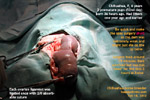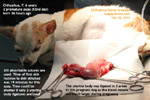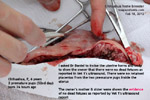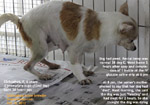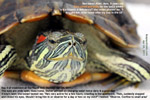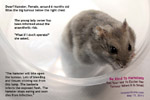Today at 10 am, she phoned me to ask whether she should continue feeding egg yolk to the same Chihuahua. "Hold on," I said as I went to ask Dr Daniel as to what was happening. "She said the dog had died."
I asked the mother. "Oh, the dog was dying. She fainted but I could see her breathing. After 2 hours in this position, the dog woke up and is now OK."
This was incredible as I could not understand why the dog had died. Her death was on my mind this morning. She did have a cyanotic tongue on picture taking. She was taken home 2 hours after my surgery and Dr Daniel had checked she was OK.
BACKGROUND
Tuesday Feb 14, 2012 (Valentine's Day)
Home breeder Mr Lim phoned me to ask about Caesarean cost. I had charged $250-$300/Caesarean for breeders some 7 years ago and that was how he knew me as I was in the breeder Caesarean section business doing over 100 dystocias.
"The fees were too low," I had stopped servicing the breeders some 4 years ago. "It should be around $800 - $1,000."
VET 1 TREATMENT. Mr Lim was in Malaysia and so he sent his mum to Vet 1, a vet to get an IV drip first as his mum said the dam was dying since giving birth to two dead pups discovered on Monday morning. Now, it was Tuesday 1 pm and many hours had passed.
Vet 1 also did a blood test and ultrasounds. Possibly two dead fetus according to the ultrasound. I palpated the abdomen. There was a small firm lump of 8 cm x 8 cm which would be just the uterine body as a pup would be 2x larger. In any case, the mum said there were dead pups and so Caesarean was needed. But Mr Lim had instructed that I did it, and so the mum and daughter carried the Chihuahua and the IV drip bottle of 5% glucose saline, ultrasound and blood test from Vet 1 to my Surgery.
Home breeders want the least cost Caesarean sections and he just wanted Vet 1 to give the dog an IV drip first before sending to me. But he had the ultrasound and blood test. It was more costly now.
I spoke to Mr Lim by phone and advised spaying as the dog is 6 years old and had difficulty giving birth now. Mr Lim agreed and so I used this case as a demonstration of how I did a spay on a pregnant Chihuahua to Dr Daniel who had joined the Surgery after his recent graduation.
There was milk in the glands and so it was a surprise that Mr Lim said the pups born premature were 50-52 days. But he is a professional experienced home breeder and so I would accept his calculation.
The dog was severely dehydrated. She was extremely weak as she had not been treated by any vet after her premature births of 2 pups. Therefore Vet 1 had given the glucose saline drip as instructed by Mr Lim. It is a mystery as to why Mr Lim phoned me to perform a Caesarean section for his dog as I had not seen him for over 4 years after I had given up on providing $250-Caesarean section to the Pasir Ris dog breeders as I was barely making ends meet and had no time for pet owners unlike now.
The ultrasound
report from Vet 1 indicated one or two dead fetuses.
This is where X-rays would be more useful as the
skeletal features of the fetuses would be visible. Or
there could be a mis-interpretation of the ultrasound
by Vet 1. Abdominal palpation by me did not reveal any
hard lump of dead pups. Yet, there was the ultrasound
report from a "brand-name" veterinary practice stating
the existence of one or two dead fetuses. I advised a
spay. The dam went home 2 hours after the spay and two
hours later, the mum had phoned Dr Daniel saying that
the dog had "died." The next morning, I answered the
phone and she asked whether she should feed the dog
"egg yolk" or not.
So, this was an unusual case of a Chihuahua that had
not really died and had been operated for some 10
minutes without the need of isoflurane anaesthesia,
indicating that she was near death's door. Normal dogs
and any person will need the anaesthetic gas as they
will feel the pain of tying the ovarian ligaments,
clamping and incisions.
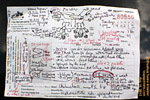 She
had a bottle of IV glucose saline before and after
Caesarean section. As at Feb 19, 2012 as I write this
report, she is OK. Chihuahuas are very fragile dogs
and when stressed out or hypoglycaemia, many don't
recover despite treatment. So, anaesthesia can be
fatal in such situations. In this case, the vet has to
make a judgment as to whether to operate or not. If
the dog dies when a Caesarean section is requested due
to dystocias, the vet is to be blamed for not
operating. If the vet operates and the dog dies, the
vet is also blamed sometimes. It is best to give the
IV drip of glucose and antibiotics for some 15 minutes
before surgery and get the whole surgery from start to
finish in less than 15 minutes. In this case, 19
minutes were taken but that was as fast as I could do
as the dog did struggle when she woke up in the last
part of surgery - ligating the uterine body. So there
was a delay as she was given low doses of isoflurane
at 1% and I stopped surgery for a while. Do not
attempt to give 5% isoflurane in such situations as
that could be fatal.
She
had a bottle of IV glucose saline before and after
Caesarean section. As at Feb 19, 2012 as I write this
report, she is OK. Chihuahuas are very fragile dogs
and when stressed out or hypoglycaemia, many don't
recover despite treatment. So, anaesthesia can be
fatal in such situations. In this case, the vet has to
make a judgment as to whether to operate or not. If
the dog dies when a Caesarean section is requested due
to dystocias, the vet is to be blamed for not
operating. If the vet operates and the dog dies, the
vet is also blamed sometimes. It is best to give the
IV drip of glucose and antibiotics for some 15 minutes
before surgery and get the whole surgery from start to
finish in less than 15 minutes. In this case, 19
minutes were taken but that was as fast as I could do
as the dog did struggle when she woke up in the last
part of surgery - ligating the uterine body. So there
was a delay as she was given low doses of isoflurane
at 1% and I stopped surgery for a while. Do not
attempt to give 5% isoflurane in such situations as
that could be fatal.
 TOA
PAYOH VETS
TOA
PAYOH VETS

